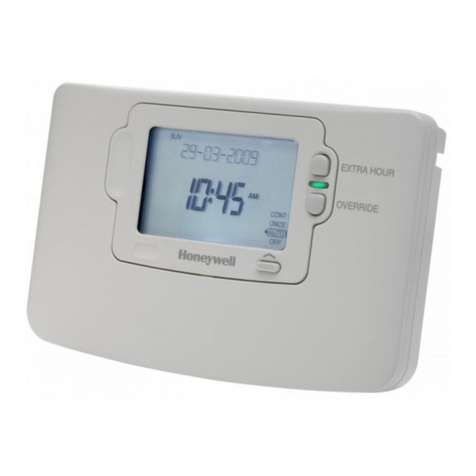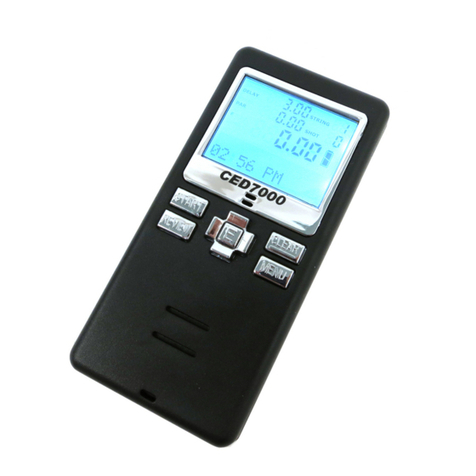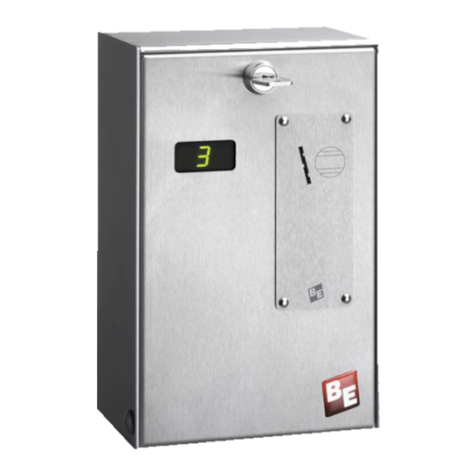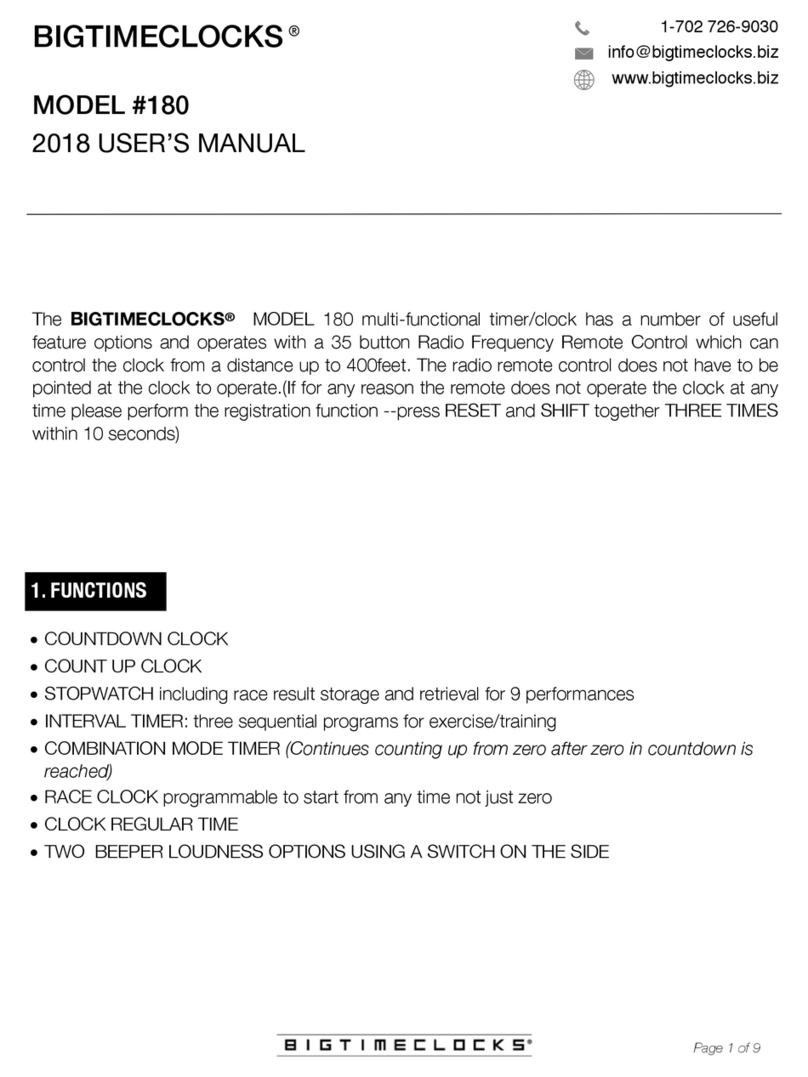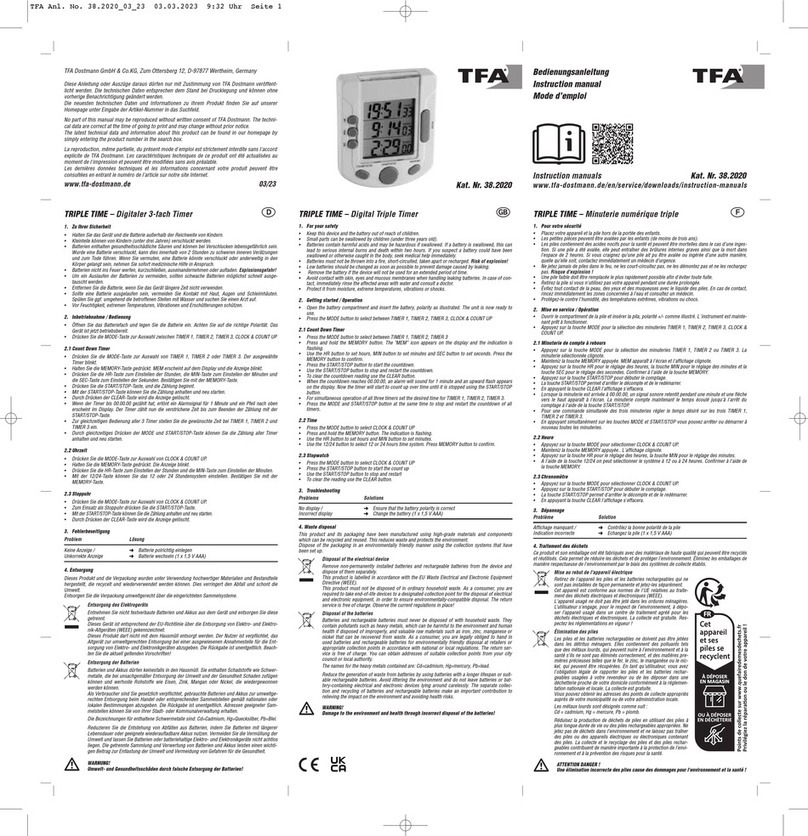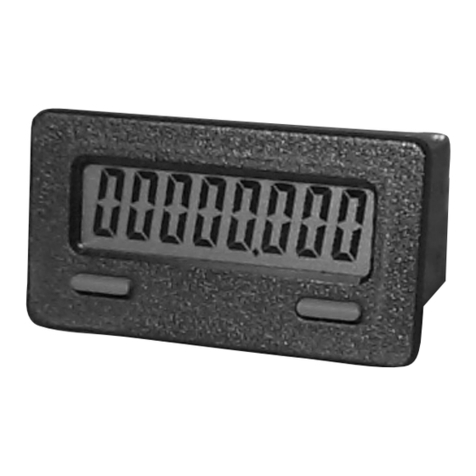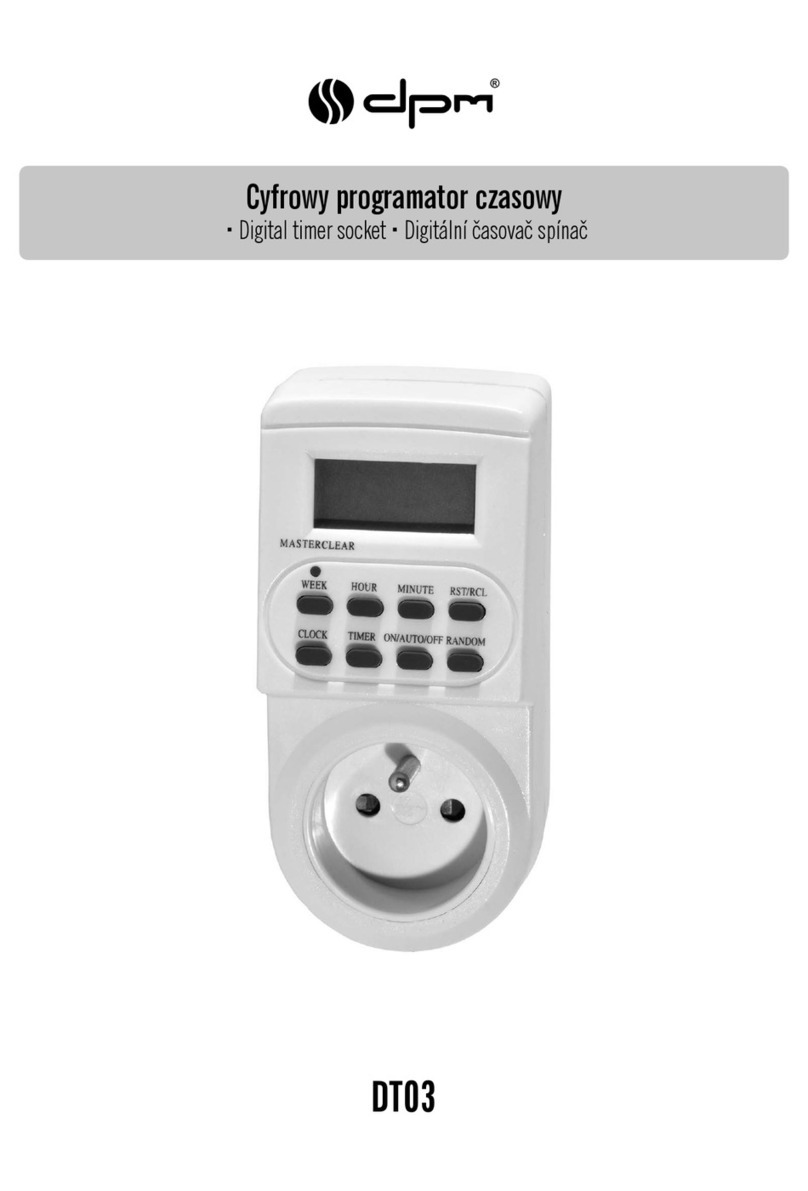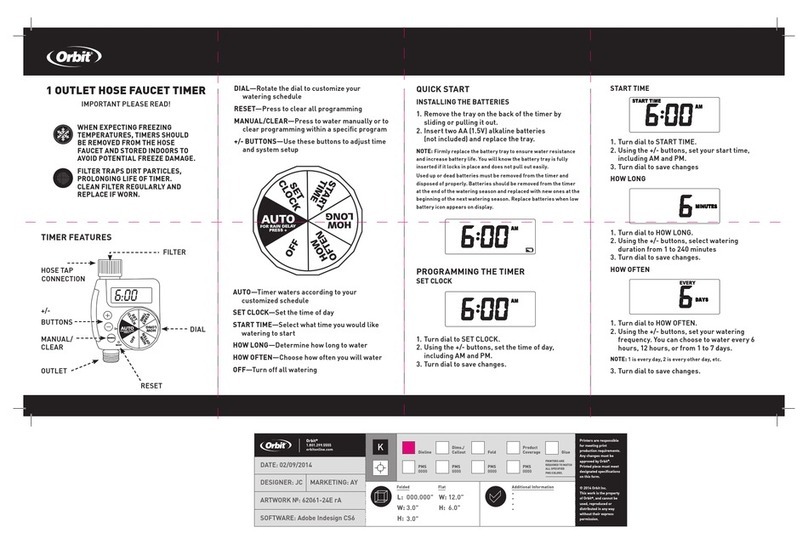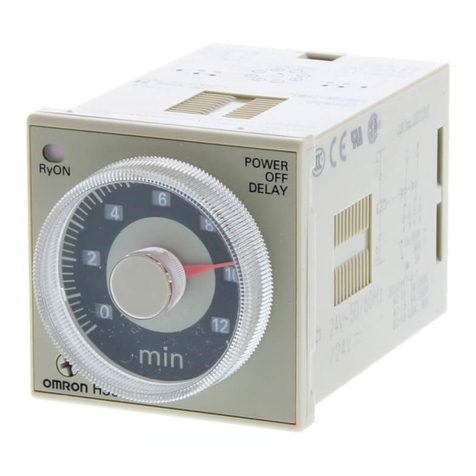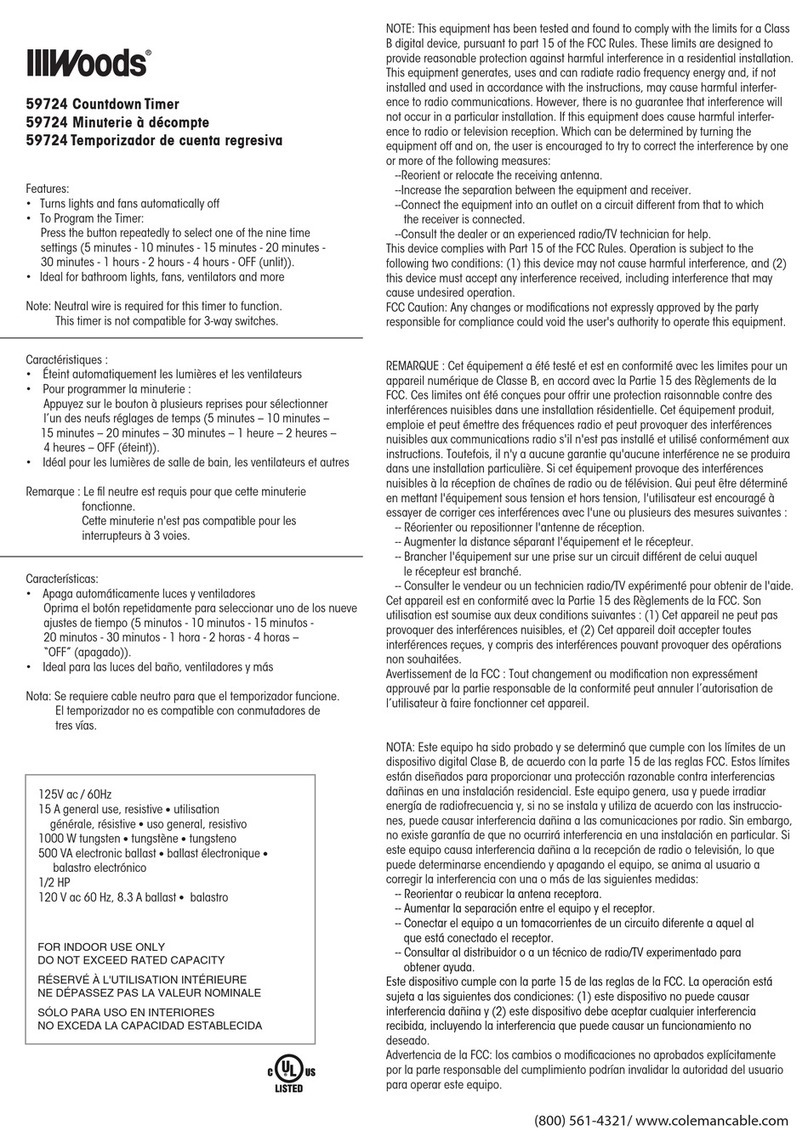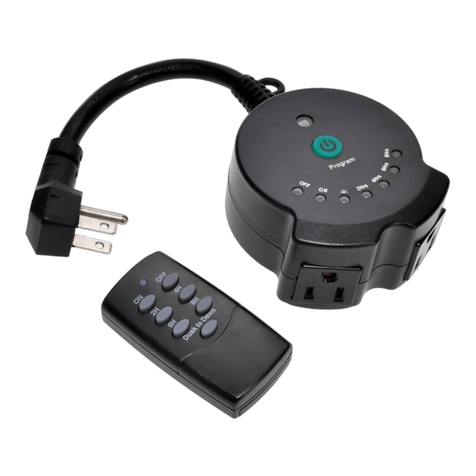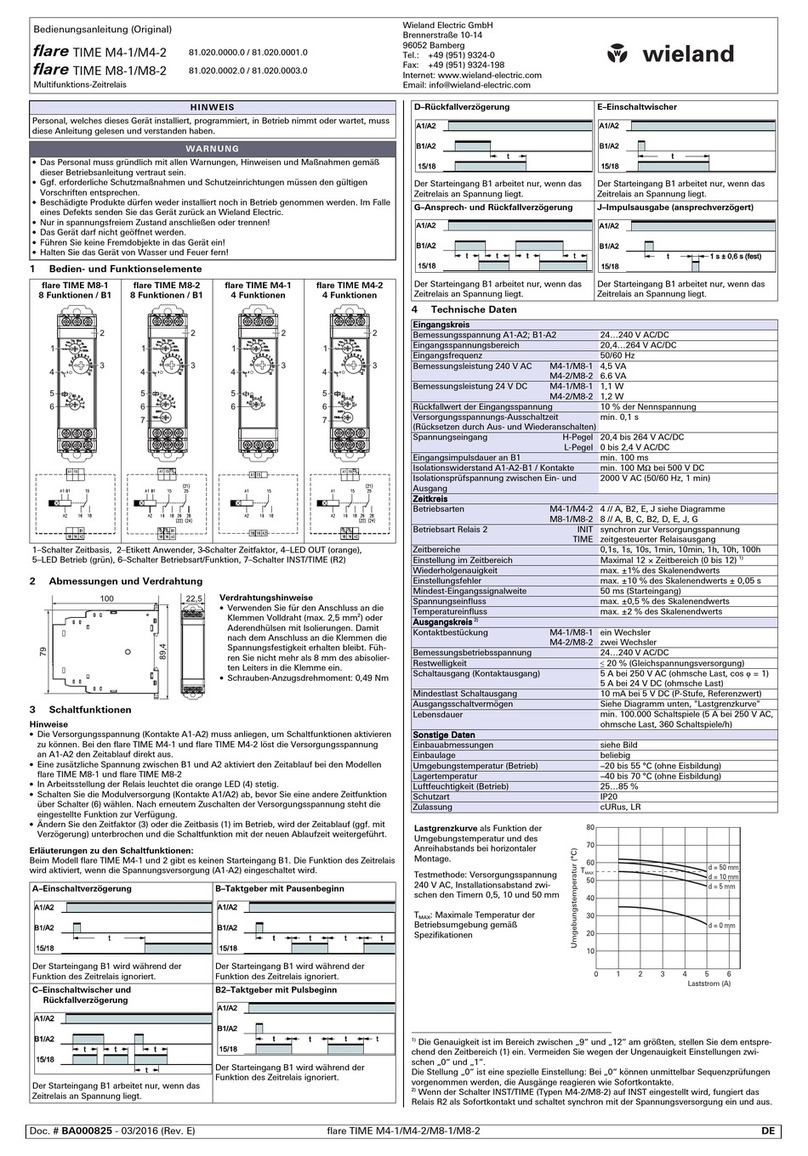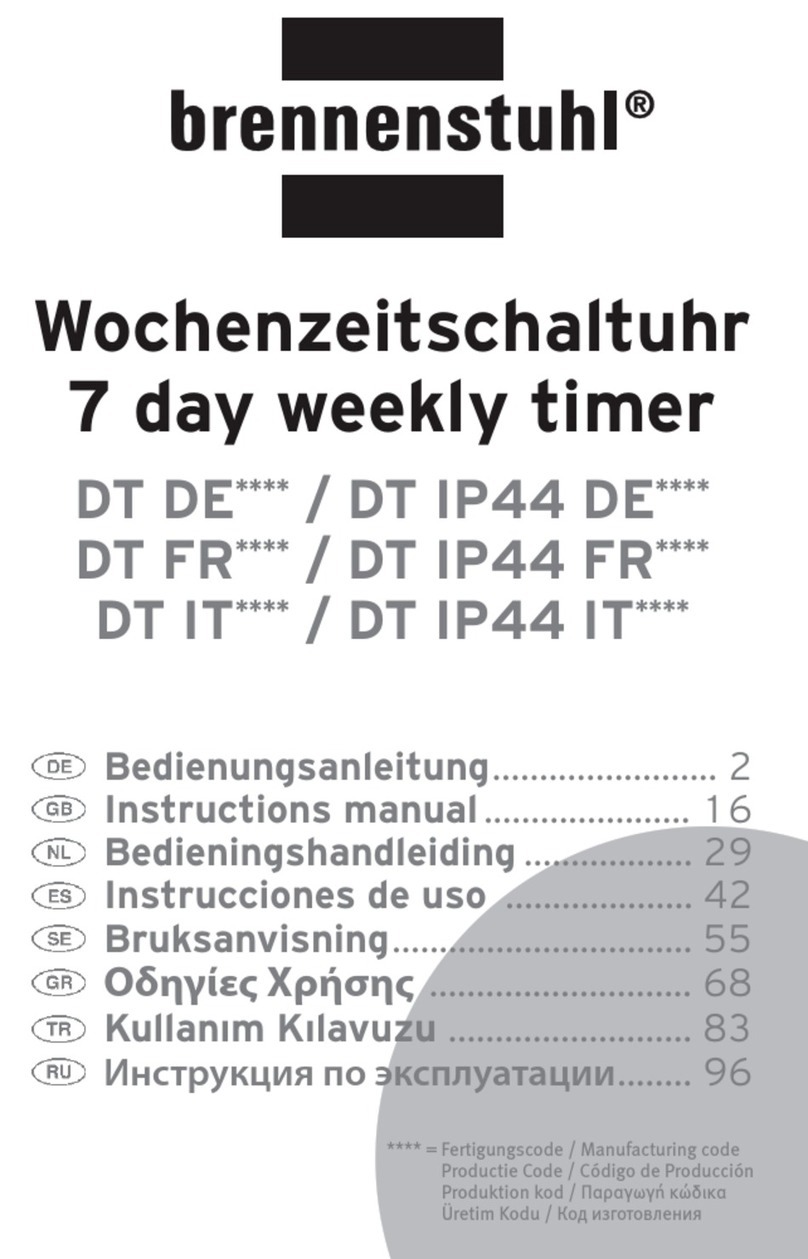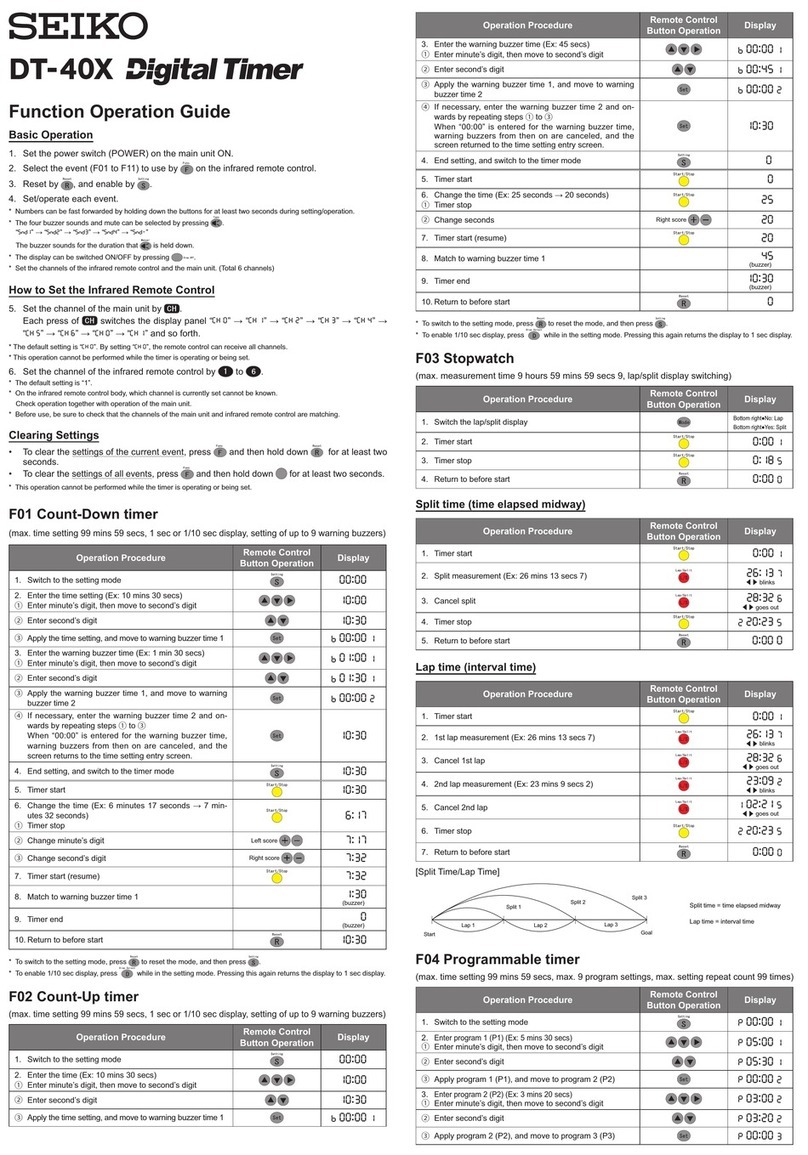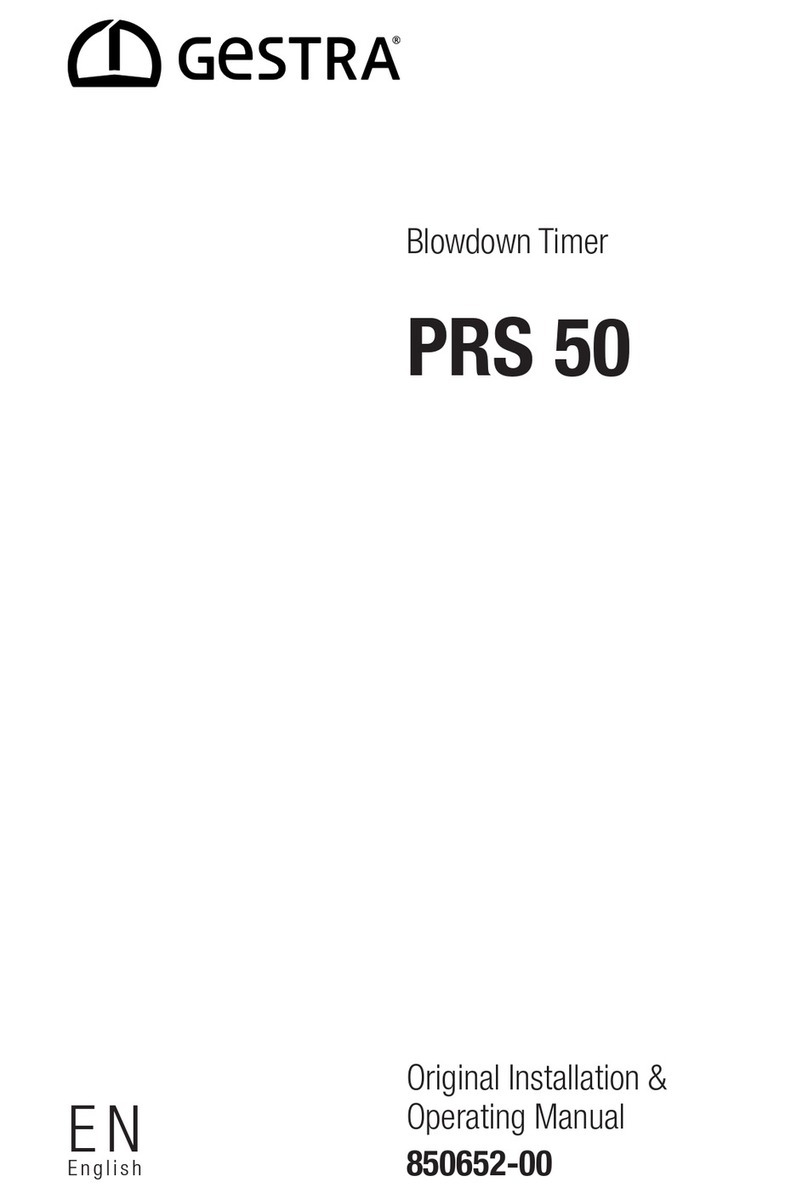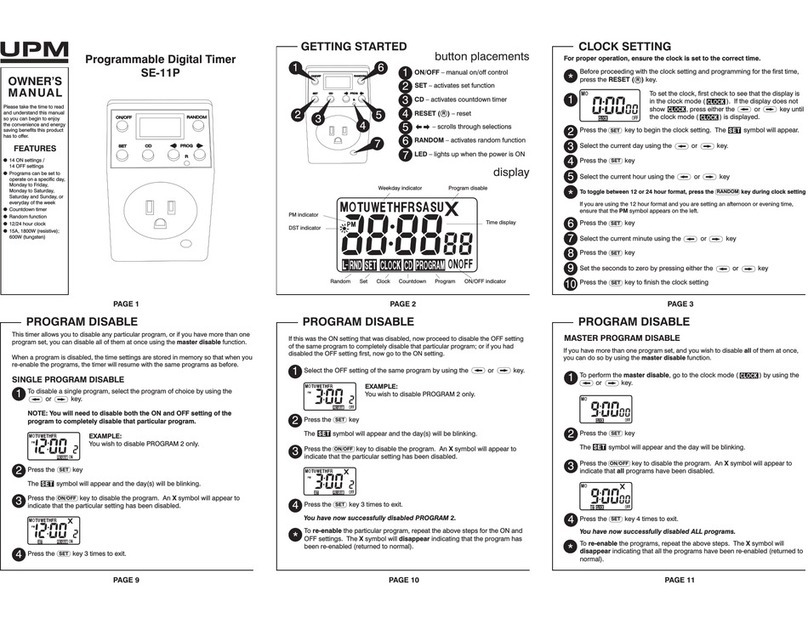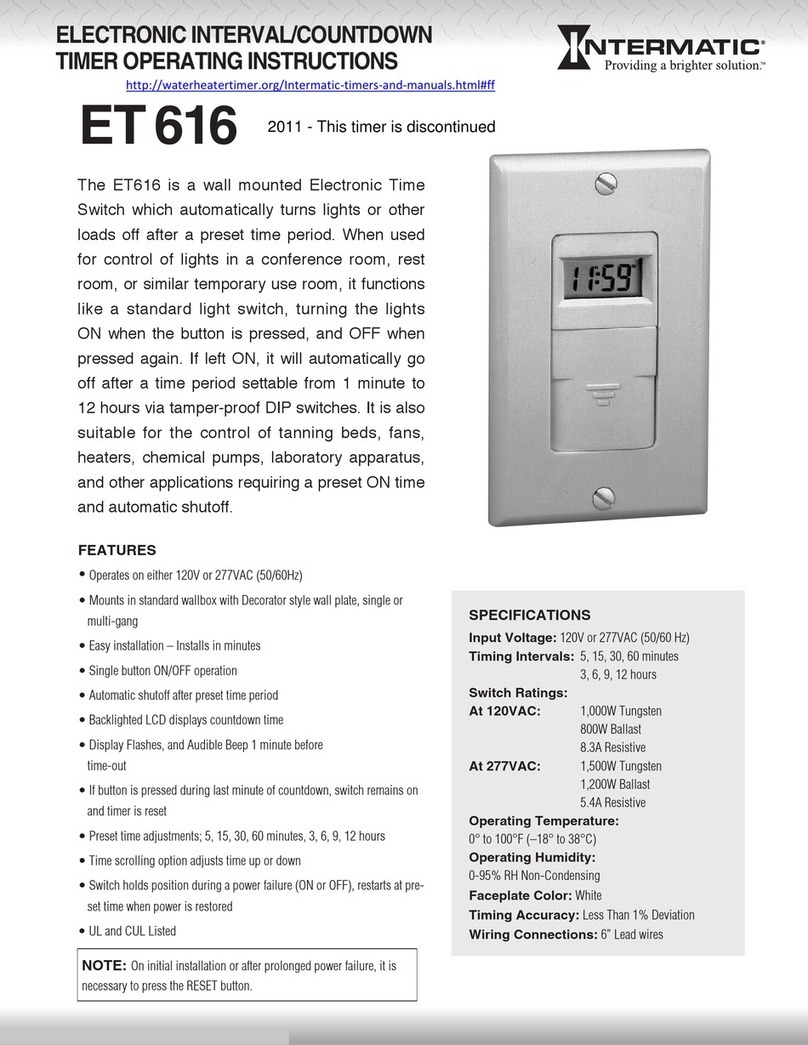Auber Instruments JSL-74A User manual

AUBER INSTRUMENTS WWW.AUBERINS.COM
2021.06 P1/4
JSL-74A General Purpose Timer
Version 1.1 (June, 2021)
1. Overview
This JSL-74A timer can count from 0.01 second to 9999 hours. Operating
function modes include single delay, double delay, and cycle delay. It can
count-down or count-up. This timer can be activated automatically when
powering up, by front key pad, or via remote switch.
2. Specification
Timer range: 0.01 seconds to 9999 hours.
Timer mode: single delay, double delay, cycle delay.
Timer trigger: power on, front key pad, or remote switch.
Timer accuracy: < 1 s/day.
Power supply: 90 - 260 V AC or DC.
Power consumption: < 2 W.
Relay output: 7 A @ 240 VAC, 10 A @ 120 VAC and 24 VDC.
Average relay life: 100,000 times at rated current.
Operating temperature: 0 - 60° C.
Humidity: 0-95% RH.
Panel cutout: 44.5 x 44.5 mm.
Outer dimension: 48 x 48 x 85 mm.
3. Front Panel
1
3
2
4
5
6 7 8 9
10
Figure1. Front panel of JSL-74A timer.
1. Time unit indicator: by default, the screen turns on when time format is
MM:SS (Minutes: Seconds) or HH:MM (Hours: Minutes) and flashes when the
timer is running; The screen turns off when time unit is M (Minutes) or S
(Seconds).
2. Timer indicator for seconds: turns on when the time format is MM:SS or S;
turns off when the time format is HH:MM or M.
3. Timer indicator for minutes: turns on when the time base is HH:MM or M;
turns off when the time base is MM:SS or S.
4. RUN indicator: turns on when timer is running; blinks when timer is paused;
turns off when timer is stopped.
5. OUT indicator: turns on when relay is on; turns off when relay is off.
6. SET key: press it momentarily to set T1 and T2; press and hold it for 3
second will enter the programming mode. In programming mode, press it
momentarily will go to next parameter setting. This key is disabled when timer
is running.
7. Down key / STP key: This key reduces the value in the programming mode;
when the timer is running, press it to stop the timer. (For a special stop function
in single delayed on mode, please see note 1 on page 2 for details).
8. Up key / PAU key: This key increases the value in the programming mode;
when timer is running, pressing & holding this key will pause the timer. Once
you release the Up key/ PAU key, the timer will resume.
9. RST key: reset key. When the timer is running, the reset button will reset the
timer. If "RUN" parameter is set to RST, pressing the button will start the timer
after it has powered up.
10. LED digital display: during normal operation as a timer, the top displays the
actual time; the bottom displays the preset value; in programming mode, the
top displays the parameter, and the bottom displays the parameter value.
4. Terminal Assignment
6
7
8
9
10
1
2
3
4
5
NC
OUT
NO AC
90~260V
STP
PAU
RST COM
Figure 2. Terminal assignment of JSL-74A.
Details:
1. Power for the timer needs to be connected to terminal 9 and 10. The voltage
should be in the 90 to 260VAC range, like 110V AC or 240V AC.
2. Terminal 6, 7, and 8 are for relay output. Terminal 6 is normally-closed (NC)
contact. Terminal 8 is normally-open (NO) contact. Terminal 7 is common
contact of the terminal 6 and 8. When the relay is energized (or when the OUT
LED is on), terminal 8 connects to terminal 7, and terminal 7 disconnects
terminal 6; When the relay is NOT energized (or when the OUT LED is off),
terminal 6 connects to terminal 7, and terminal 7 disconnects terminal 8. The
relay is a “dry switch” that does not provide power by itself. Please see the
wiring examples in Section 7.
3. Terminal 5 is the reset terminal that has the same function as the RST key in
the front panel. Please see a note at the end this section.
4. Terminal 4 is the pause/mute terminal that function the same as the “^/PAU”
key in the front panel.
5. Terminal 3 is the stop terminal that function the same as the “V/STP” key in
the front panel.
6. Terminal 1 is the common contact for the terminal 3/4/5. There are two ways
to operate terminal 3, 4 and 5.
6.a) Connecting a normally open (NO) momentary push button switch between
the terminal (3, 4 or 5) to the COM (1). Please note, the function starts when
you release (or open) the button of the switch, not when you press down the
switch. See Figure 5.
Instruction Manual

AUBER INSTRUMENTS WWW.AUBERINS.COM
2021.06 P2/4
6.b) Connect a DC logic signal (TTL or CMOS or voltage in the range from 3 to
30 VDC) between the terminal (3, 4 or 5) to the COM (1). Please note, the
function is rising-edge triggered. The logic signal should normally be at a high
level. The function starts when the signal goes from low to high. If you have an
inverted logic signal, you need to connect a NPN transistor between the
terminal and COM; add 10Kohm resistor to the gate for signal input. See
Figure 6 for details.
7. Terminal 2 is reserved for customized applications.
Note for terminal 3, 4, and 5. These terminals are activated by the rising
phase of control signal. If the control signal is from a NO switch that is
connected to the terminal, the action starts when the switch is released (from
close to open). When the control signal is received from an external device, the
action starts as the voltage goes from low to high.
5. How to Set the Timer and Relay Delay Time T1/T2
Press “SET” key momentarily, and T1 will show up at the top display. Use Up
and Down key to set the value. Press SET again to set the T2 (only for delayed
interval or cycle mode). Press SET key to confirm the setting and exit the timer
setting mode.
When adjusting the time, each time the Up or Down key is pressed, the value
will increase by one unit. But if key is held, the value will continuously increase,
as the holding time increases, the speed of number increasing will accelerate.
You can use this feature for large number increment. When the number is
getting close to desired value, release the key. Press it momentarily for fine
setting adjustment.
6. Programming
0110
0110
Process Value
Set Value
SET
OUT
OFDL
OUT
OFDL
tdir
dn
SET
FUNC
SDL
RUN
RST
Func
SdL
RUN
rSt
SET
SET
Hold 3s
SET
T1
S
T2
S
tdir
dn
T1
S
T2
S
SET
PoM
ON
SET
pom
on
SET Exit
Figure 3. Flow chart of how to program JSL-74A.
Press the SET key for 3 seconds to enter programming mode. To reach
individual parameter settings, use up/down key to select different programming
values. Press the SET key to confirm and move on to next parameter. See
Figure 3 for the procedure. For the definition of each programming value, see
following section.
Definition of Programming Parameters
Func, timer operating function mode. Available options are:
SdL (single delay): relay turns on at the beginning of relay delay time T1
(OFDL); relay turns on at the end of relay delay time T1 (ONDL). It will not
change until the timer is reset or repowered again. In Single Delay ON mode, a
special parameter for stop function, STOP will show up in the parameter menu.
For details please refer to note1 below.
dint (delayed interval): relay turns on at the end of T1 time delay then off at the
end of T2 time delay (OFDL); relay turns off at the end of T1 time delay then on
at the end of T2 time delay (ONDL). There is no repeat.
CYCL (cycle): repeat relay on and off in cycle. Relay turns on at the end of T1
time delay then off at the end of T2 time delay (OFDL); relay turns off at the
end of T1 time delay then on at the end of T2 time delay (ONDL). It will repeat
this cycle until power is off.
T1 or T2, timer range. Available options are:
S: 0.01 s ~ 99.99 s.
M:S: 1 s ~ 99 m 59 s.
M: 1 m ~ 9999 m.
H:M: 1 m ~ 99 h 59 m.
H: 1 h ~ 9999 h.
D:H: 1 h ~ 99 d 23h.
tdir, timing direction. Available options are:
up: counting up.
dn: counting down.
PoM, power-on memory setting. Available options are:
After a loss of power, this timer can be set to either reset when power is
restored, or continue running from the point of power outage.
ON: After a loss of power, this unit will continue running from the point of power
outage when power is restored.
OFF: After a loss of power, this unit will be reset when power is restored.
OUT, relay output mode. Available options are:
OFDL (off delay): relay will be on at the start of timer and off when time reach
the set point.
ONDL (on delay): relay will stay off at the start of timer and on when time reach
the set.
RUN, timer starting run mode. Available options are:
PU (power up): When timer is powered up, timer will start counting.
rSt (reset): When reset button is pressed and released, timer will start counting.
Note 1: Running the single delayed on mode.
When running the Single Delay On mode, depending on the applications, users
may want the relay to stay at off (initial state), or stay on (final state) when the
operation is interrupted by stop function. Examples. A) Some user uses the
timer to turn on a buzzer at the end of a process for notification purpose. He
wants to be able to disable the buzzer (change to initial state) by simply

AUBER INSTRUMENTS WWW.AUBERINS.COM
2021.06 P3/4
pushing a button once he acknowledged the notification. B) Some users want
to delay the process of turning on an oven. But sometimes, they may want to
cancel the delay (change to the final state) to start the oven by pushing the
stop key. In order to satisfy these two conflict requirements, a special
parameter for stop function, STOP will show up in the parameter menu when
both ONDL (on delay) and SDL (single delay) are selected, STOP can be
selected as 0 (default) or 1. When it is set to 0, during the delay, stop signal will
set relay to the final state (pulled-in). When it is set to 1, during the delay, stop
signal will set the relay to the initial state (dropped-out). When the time delay is
finished and relay pulled in, user can reset the relay to the initial state by
sending a stop signal, regardless of the STOP setting.
7. Wiring Examples
1) Signal controlled by external switches.
In the timer, power (120 or 240V AC) is sent to terminal 9 and 10.The external
reset (RST) and pause (PAU) switch should be momentary type. These keys
are only needed if you want to control the timer remotely. Otherwise, you can
use the front keys on the timer. These switches can also be replaced with a
control signal from computer or other control devices. The alarm speaker
used in this example is also optional. It is to show how to wire the output.
You can substitute it with any output such as a coffee grinder. The output
terminals (#6, 7 and 8) are from a “C form” internal relay. It is a dry switch that
does not provide the power by itself. In this case, the alarm is powered by the
120VAC. The external switch connected to the alarm is for disabling the sound
if needed.
6
7
8
9
10
1
2
3
4
5
L
N
120VAC
RST
PAU
Figure 4. Wiring example of JSL-74A.
2) Signal controlled by DC logic signal.
6
7
8
9
10
1
2
3
4
5
L
N
120VAC
Figure 5. Rising-edge triggered signal.
6
7
8
9
10
1
2
3
4
5
L
N
120VAC
10k e
b
cNPN
Figure 6. Inverted logic signal.
8. Timing Diagrams
Following diagrams show relay output ON/OFF time under different relay
output modes and operating function modes. Please note: 1) “RUN” is set to
“rSt” in following examples, powering up to start the timer is not discussed here.
2) Timer starts counting from the moment when the reset key/switch is
released or input (TTL) signal is from low to high. 3) The timer display stops
counting as soon as stop key/switch is pressed (from high to low), but relay
output will only be triggered when stop key/switch is released (from low to high).
Power
Relay
output
Reset
Pause
Stop
T1 Ta Tb
Ta+Tb=T1
A. single delay (delay off).
Power
Relay
output
Reset
Pause
Stop = 0
T1
Ta Tb
Ta+Tb=T1
Stop = 1
B. single delay (delay on) (for stop function please see Note 1 on page 2 for
details).
Power
Relay
output
Reset
Pause
Stop
T1 Ta Tb
Ta+Tb=T1
T2 T2
C. delay interval (delay on).

AUBER INSTRUMENTS WWW.AUBERINS.COM
2021.06 P4/4
Power
Relay
output
Reset
Pause
Stop
T1
Ta Tb
Ta+Tb=T1
T2 T2
D. delay interval (delay off).
Power
Relay
output
Reset
Pause
Stop
T1 Ta Tb
Ta+Tb=T1
T2
T2 T1
T2
E. cycle (delay on).
Power
Relay
output
Reset
Pause
Stop
T1
Ta Tb
Ta+Tb=T1
T2 T2
T1
T2
F. cycle (delay off).
Auber Instruments Inc.
5755 North Point Parkway, Suite 99,
Alpharetta, GA 30022
www.auberins.com
Copyright © 2021 Auber Instruments Inc. All rights reserved.
No part of this datasheet shall be copied, reproduced, or transmitted in any
way without the prior, written consent of Auber Instruments. Auber Instruments
retains the exclusive rights to all information included in this document.
Other Auber Instruments Timer manuals
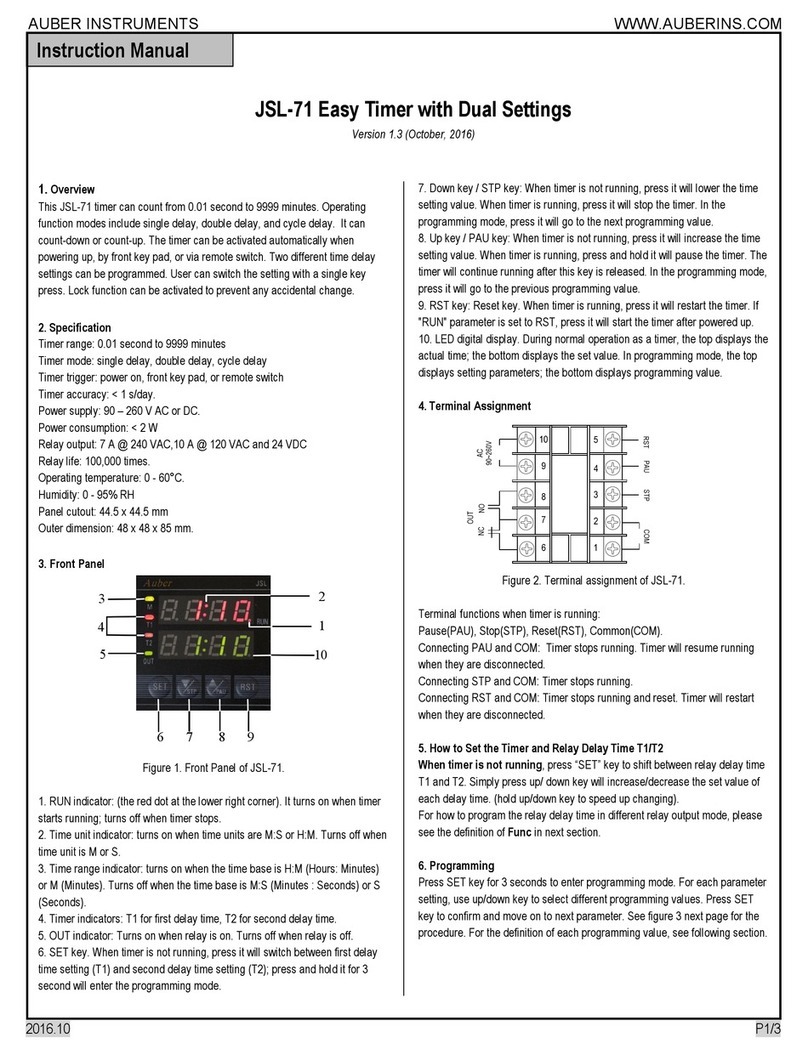
Auber Instruments
Auber Instruments JSL-71 User manual
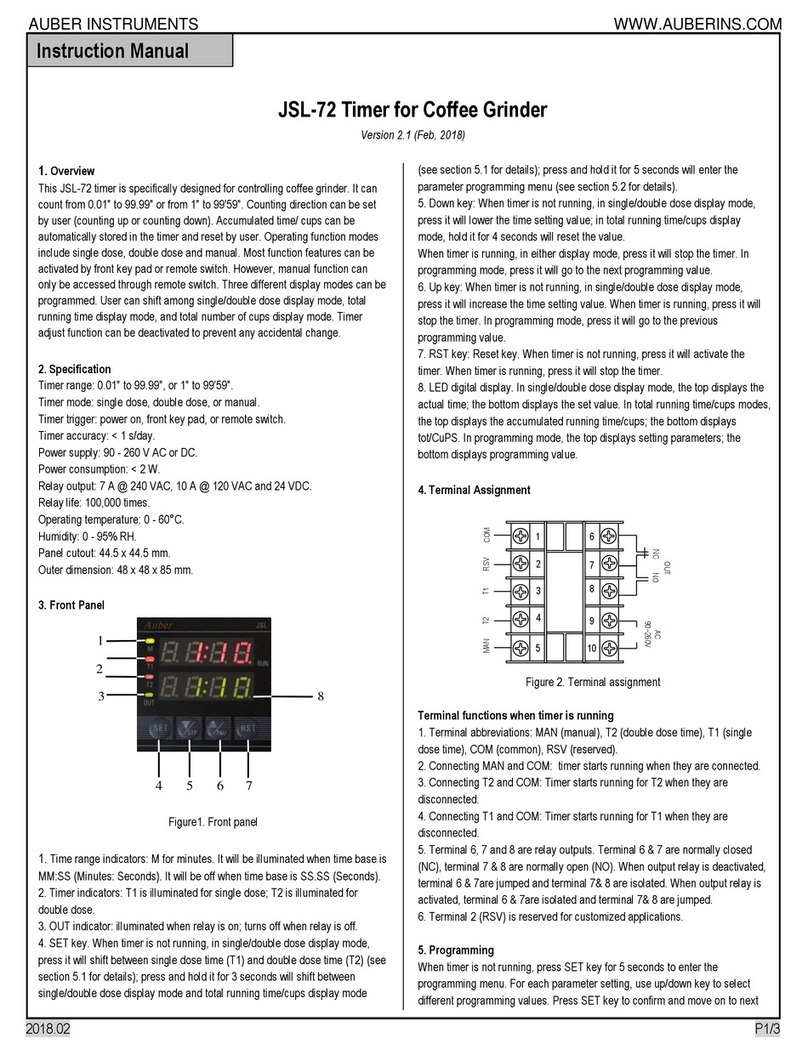
Auber Instruments
Auber Instruments JSL-72 User manual
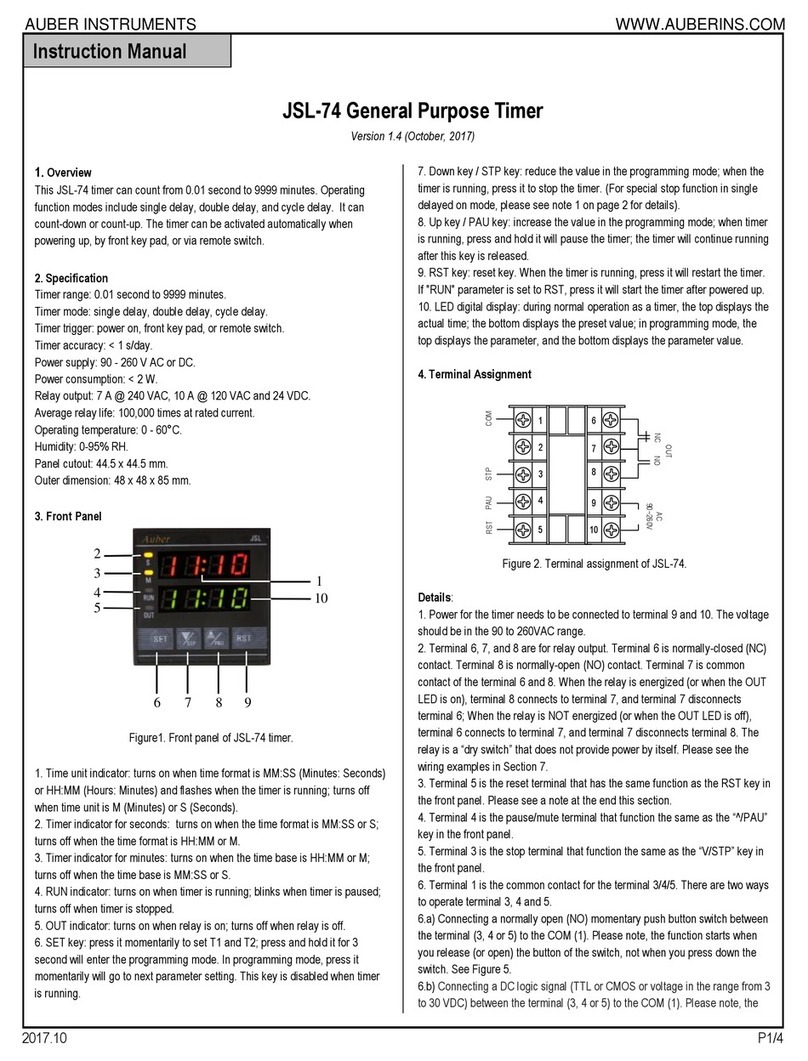
Auber Instruments
Auber Instruments JSL-74 User manual
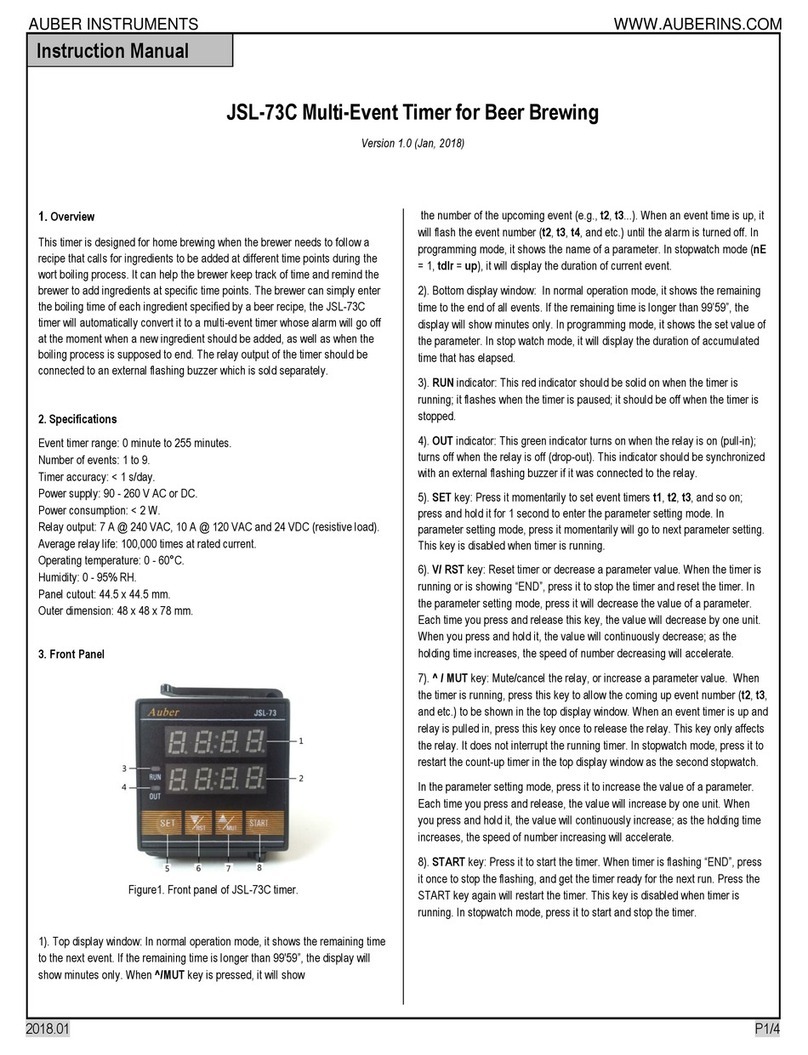
Auber Instruments
Auber Instruments JSL-73C User manual
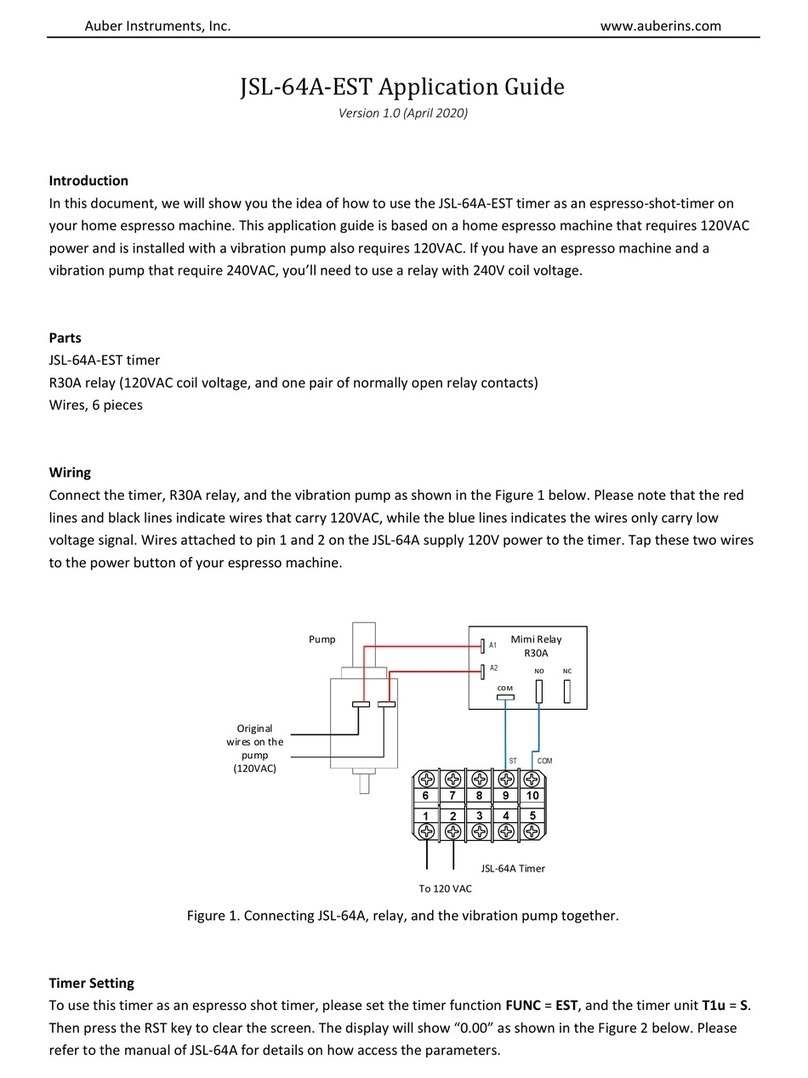
Auber Instruments
Auber Instruments JSL-64A-EST User guide
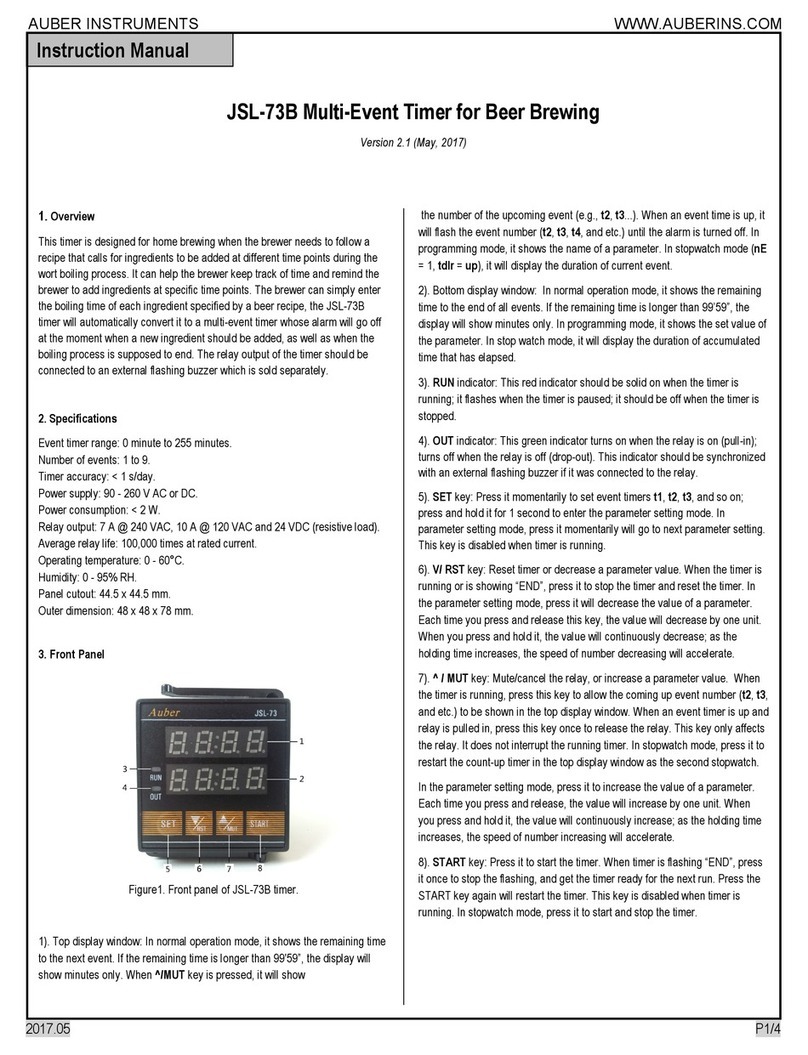
Auber Instruments
Auber Instruments JSL-73B User manual
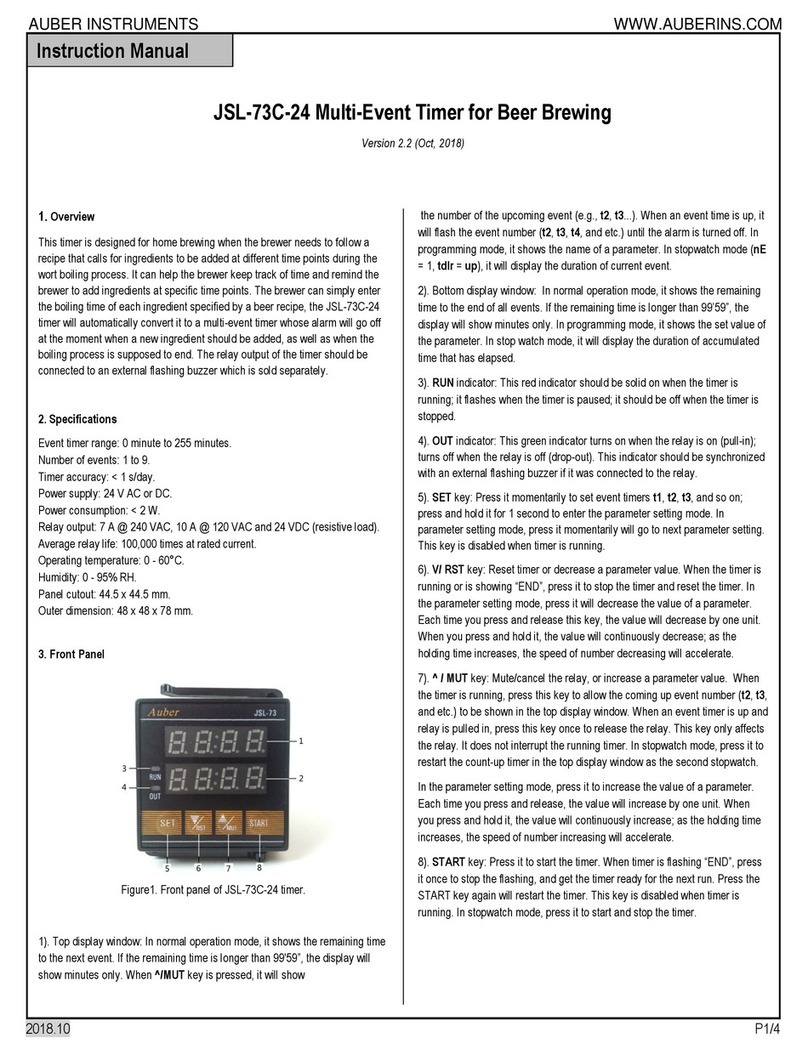
Auber Instruments
Auber Instruments JSL-73C-24 User manual

Auber Instruments
Auber Instruments JSL-72 User manual
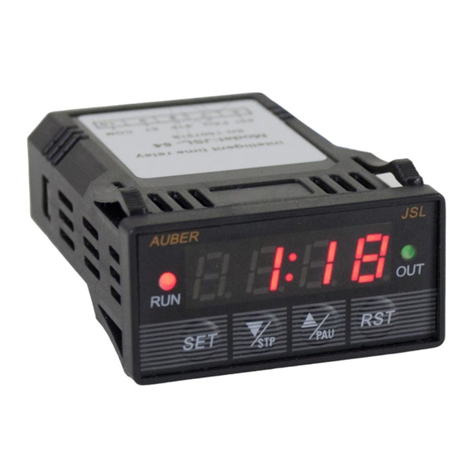
Auber Instruments
Auber Instruments JSL-64A User manual
